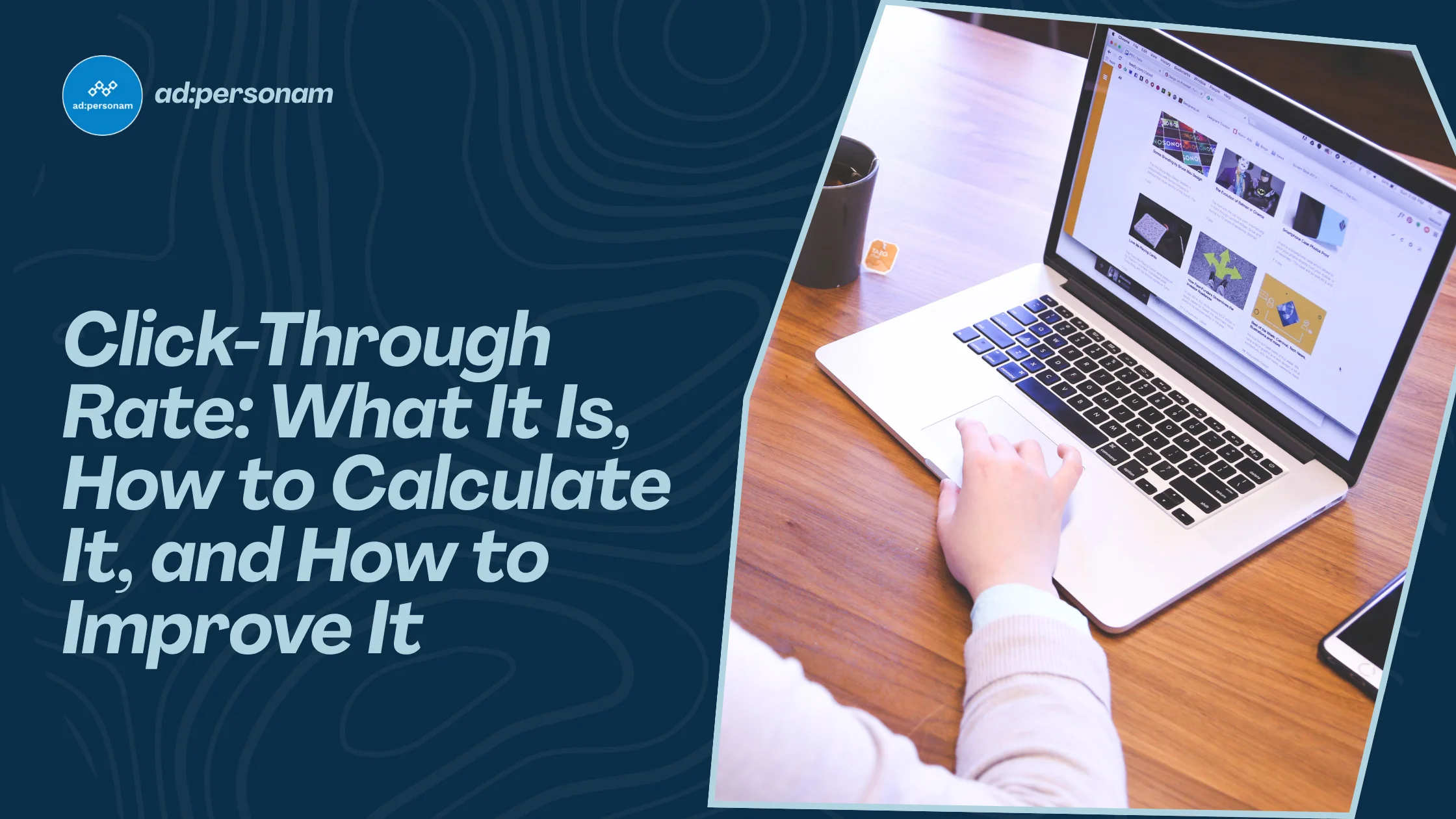Click Through Rate (CTR): What It Is, How to Calculate and Improve It
Discover what click through rate is, how it's calculated, and why it's crucial for your programmatic marketing campaigns
Contents
- CTR Definition and Formula
- How CTR is Calculated Across Different Platforms
- Why CTR Matters in Digital Marketing
- What is a Good CTR Value? Benchmarks and Average Values by Sector
- Advanced Strategies to Improve CTR
- Does CTR Influence Google Ranking?
- Common Mistakes That Lower CTR and How to Avoid Them
- Tools and Metrics for Monitoring CTR
- Testing, Experimentation, and Continuous Optimization
- FAQ: Most Frequently Asked Questions About Click-Through Rate

The click through rate, abbreviated as CTR, is one of the most important metrics for evaluating campaign effectiveness in digital marketing. Understanding how it works and how to improve it is essential for optimizing conversions, refining advertising strategies, and measuring the real relevance of messages delivered across every digital channel.
CTR Definition and Formula
CTR represents the ratio between the number of clicks received and the number of times content or an ad was shown, i.e., impressions. The formula is simple: CTR = (clicks ÷ impressions) × 100. For example, if an ad receives 50 clicks out of 1,000 impressions, we get 50 ÷ 1,000 = 0.05, resulting in a 5% CTR. However, CTR doesn't always tell the whole story. If an ad receives many clicks but doesn't generate conversions or quality visits, its value, though high, can be misleading.
It's a useful metric for understanding initial interest, but it should be interpreted alongside other data such as conversion rate and time on page.
How CTR is Calculated Across Different Platforms
The CTR calculation follows the same formula, but operational methods vary by platform.
In search engines, an impression occurs when a result appears in the SERP. In PPC channels like Google Ads, impressions are counted when the ad is displayed on screen.
On Facebook, a post counts as an impression even if it was only partially loaded in the feed, while on LinkedIn the system considers actual views. In carousel or video formats, the denominator may only include actual impressions per slide or playback start.
For email marketing, CTR is calculated on opened messages and is called click-to-open rate, which measures the percentage of users who click a link relative to those who actually opened the email. In online video, the view-through rate comes into play, measuring the ratio between views and completions or interactions.
It's important to distinguish between relative CTR (for individual format or channel) and absolute CTR (for total campaign) and normalize data for comparison, using tools like Google Ads, Search Console, or email automation platforms to extract and harmonize the numbers.
Why CTR Matters in Digital Marketing
CTR is a performance indicator that helps determine whether a headline, ad, or creative is actually relevant to the audience. A high CTR suggests the message meets user expectations, while a low value indicates poor relevance or targeting issues. A good CTR means overcoming the first hurdle: attracting interest. From there, the conversion rate takes over, measuring the percentage of users who complete the desired action. In PPC systems like Google Ads, CTR also contributes to the quality score—the score Google assigns to each ad that influences position and cost per click. Improving CTR, therefore, means optimizing visibility and reducing costs.
What is a Good CTR Value? Benchmarks and Average Values by Sector
A good CTR value depends on context, channel, and content type. An ad in the first SERP position can reach 20% CTR, while an organic result in third position might settle around 5%. In display advertising, CTRs are generally lower, often under 1%, while in highly targeted campaigns or emails with qualified databases they can exceed 10%. The key is building internal benchmarks and monitoring trends over time.
Many platforms, like ad:personam, allow you to monitor CTR and campaign performance with customizable internal dashboards.
Advanced Strategies to Improve CTR
Optimizing your CTR requires a structured approach. For organic results, crafting the title tag and meta description is the first step. Testing alternative headlines with A/B tests helps identify what works best. In PPC, it's important to work on clear copy, relevant extensions, and precise targeting. The mobile experience should be optimized with lightweight, easily navigable landing pages.
Strategies to Improve PPC Ad CTR
In paid ads, the goal is to maximize relevance between keyword, message, and destination page. Testing text variants with different calls to action and using ad extensions can increase CTR by 20–30%. Dynamic campaigns and automated bidding strategies based on performance also enable real-time content optimization.
Using Structured Markup and Rich Snippets
Adding structured data like reviews, ratings, or prices helps make the ad more credible and informative. An enriched result improves CTR by visually capturing attention and communicating immediate value.
Does CTR Influence Google Ranking?
According to Google, CTR is not a direct ranking factor.
However, an elevated CTR can produce indirect effects: more clicks mean more traffic, longer dwell time, and more positive behavioral signals, which over the long term can impact overall visibility and increase brand awareness.
How to Document Impact in Your Analytics
To assess the impact of CTR increases, we recommend monitoring organic traffic and average position in Search Console. Even small percentage increases can translate into greater conversion opportunities.
Common Mistakes That Lower CTR and How to Avoid Them
An unclear title reduces user trust and curiosity; vague or misleading descriptions generate low-quality clicks. A too-broad or unsegmented audience also hurts results, especially in PPC channels. Technical issues like lack of trackability or non-mobile-friendly landing pages distort measurement and lower actual CTR.
Tools and Metrics for Monitoring CTR
To reliably analyze CTR, it's essential to use the right tools. Google Search Console allows you to see CTR by query and page, while GA4 enables cross-referencing click events with landing pages. In Google Ads, you can monitor CTR and conversions at the ad group or keyword level, while email platforms provide open and click metrics. Organizing data with dashboards like Looker Studio facilitates comparison across devices, campaigns, and branded or non-branded queries.
Correlated Metrics and Useful Dashboards
Alongside CTR, always consider impressions, average position, and conversion rate. Creating a CTR dashboard allows you to visualize all these metrics in combination to act quickly when values deviate from the average.
Testing, Experimentation, and Continuous Optimization
CTR should always be treated as a dynamic metric, to be tested and improved constantly. A/B tests enable comparing variants of titles, descriptions, or images by changing just one element at a time. It's essential to define a representative sample, establish minimum test duration, and assess statistical significance to avoid misinterpretation.
A/B Tests for SEO vs. Tests for Ads
In SEO, A/B testing can be implemented by alternating title tags and meta descriptions on similar pages, while in PPC it happens directly on the platform with ad variants. The principle remains the same: optimize based on real data.
Interpreting Statistical Significance
A result is reliable only if it comes from a large, stable sample. Tools like Google Optimize or Optimizely help calculate the probability that the winning variant outperforms the baseline with acceptable margin of error.
Case Studies and Measurable Results
An apparel e-commerce improved organic CTR by 40% by rewriting titles with more benefit-oriented terms ("free shipping," "new collection"). A display campaign, instead, increased CTR from 0.8% to 1.4% using lookalike segmentation and dynamic creatives. A weekly newsletter saw click-to-open rate grow from 9% to 15% after inserting textual CTAs and highly visible buttons.
FAQ: Most Frequently Asked Questions About Click-Through Rate
How Does Click Through Rate Work?
Click through rate measures the ratio between clicks and impressions. On programmatic platforms like ad:personam, this metric allows you to evaluate how well messages attract the target audience in real-time.
When is CTR a Good Metric to Consider?
It's effective when you want to measure an ad's ability to generate immediate interest and drive action, such as visiting a page or discovering an offer.
What is CTR?
CTR is the indicator that shows as a percentage how many people clicked relative to how many saw an ad. On the ad:personam platform, it's monitored and optimized through artificial intelligence to continuously improve campaign performance.
Discover other features of ad:personam's DSP platform for your programmatic marketing ads!
You might also like

Google Analytics 4: Complete Setup, GDPR Compliance & Migration Guide
Master GA4 with event-based tracking, GDPR compliance, and Universal Analytics migration. Optimize programmatic campaigns with data-driven insights.

Third-Party Cookies: Complete Guide for Digital Marketing
Learn what third-party cookies are, how they work, GDPR compliance requirements, and cookieless alternatives for digital marketing success.

Viewability: Complete Guide to Measurement, Optimization, and KPIs
Discover what viewability is, how to measure and optimize it in your digital ads, and which KPIs to track for maximum campaign effectiveness